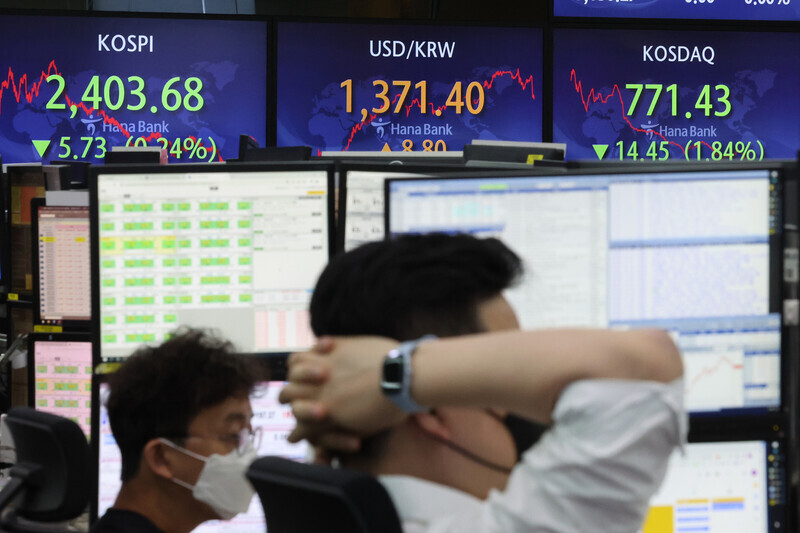hankyoreh
Links to other country sites 다른 나라 사이트 링크
Won falls further against dollar, putting exchange rate at over 13-year high

The won-to-dollar exchange rate surpassed 1,370 won, continuing to shoot up without an end in sight. The rise of the dollar’s value internationally, coupled with South Korea’s trade deficit and the weakening of the Chinese yuan, has led to the quick downfall of the won’s value.
The won-to-dollar exchange rate closed at 1,371.40 won on Monday at the Seoul foreign exchange market, having risen by 8.8 won from the previous day. The exchange rate started trading at 1,365.0 won that morning and exceeded 1,370 won before noon. The last time the won-to-dollar exchange rate surpassed 1,370 won was 13 years and five months ago, when it hit 1,392.0 won on April 1, 2009.
The KOSPI closed at 2,403.68 on the same day, having dropped by 0.24% (5.73 points) from the day prior.
The US Federal Reserve’s policy interest rate hikes have heightened the value of the dollar, considered a risk-free asset. The possibility of an economic slowdown in Europe is also pushing the dollar’s value upward.
On Friday, the state-owned Russian firm Gazprom announced that it would completely halt gas supplies to Europe through the Nord Stream 1 pipeline.
The strengthening of the dollar has led to major currencies dropping in value one after another. The US dollar index, which measures the dollar’s value relative to six major currencies including the euro, the yen and the pound, was tallied at 110.23 as of 2 pm on Monday. The dollar index in March 1973 was 100.
The last time the figure exceeded 110 was June 19, 2002 (110.19), a little over 20 years ago.
Concerns are being raised regarding whether the won’s value has been falling much more dramatically than that of other currencies. The won’s value relative to the dollar dropped by 2.35% between Aug. 26, when the Jackson Hole meeting took place, and Friday. The dollar index increased by 0.7% during the same time period, which means the value of six major currencies other than the dollar dropped by the same percentage. During the same time period, the euro’s value relative to the dollar fell by 0.13%, while the value of the yen and the yuan compared to the dollar dropped by 1.89% and 0.40%, respectively.
South Korea’s trade deficit and the weakening of the Chinese yuan are other factors contributing to the steep fall of the won. South Korea has been recording trade deficits month after month, which have been destabilizing the domestic dollar supply.
Plus, the yuan-to-dollar exchange rate hit 6.93 yuan on Sunday. The two currencies’ exchange rate has shot up dramatically since mid-April, exceeding the 6.9-yuan range since late last month. The weakening of the yuan can make Chinese products more competitive in terms of price and may threaten the competitiveness of exports from South Korea and other developing nations.
The won’s value has been dropping since June due to the strengthening of the dollar following the giant step taken by the Fed, and due to other factors such as South Korea’s faltering trade balance and the weakening of the yuan since mid-August.
“The downturn of the won seems to have entered a new phase starting on Aug. 16,” the Korea Center for International Finance stated.
During an emergency macroeconomic finance meeting, Choo Kyung-ho, South Korea’s deputy prime minister and minister of economy and finance, said, “Starting in August, factors like the worsening trade balance and the weakening of the yuan overlapped, leading to a swift increase in the won-to-dollar exchange rate.”
By Jun Seul-gi, staff reporter
Please direct questions or comments to [english@hani.co.kr]

Editorial・opinion
![[Column] Season 2 of special prosecutor probe may be coming to Korea soon [Column] Season 2 of special prosecutor probe may be coming to Korea soon](https://flexible.img.hani.co.kr/flexible/normal/500/300/imgdb/original/2024/0426/3317141030699447.jpg) [Column] Season 2 of special prosecutor probe may be coming to Korea soon
[Column] Season 2 of special prosecutor probe may be coming to Korea soon![[Column] Park Geun-hye déjà vu in Yoon Suk-yeol [Column] Park Geun-hye déjà vu in Yoon Suk-yeol](https://flexible.img.hani.co.kr/flexible/normal/500/300/imgdb/original/2024/0424/651713945113788.jpg) [Column] Park Geun-hye déjà vu in Yoon Suk-yeol
[Column] Park Geun-hye déjà vu in Yoon Suk-yeol- [Editorial] New weight of N. Korea’s nuclear threats makes dialogue all the more urgent
- [Guest essay] The real reason Korea’s new right wants to dub Rhee a founding father
- [Column] ‘Choson’: Is it time we start referring to N. Korea in its own terms?
- [Editorial] Japan’s rewriting of history with Korea has gone too far
- [Column] The president’s questionable capacity for dialogue
- [Column] Are chaebol firms just pizza pies for families to divvy up as they please?
- [Column] Has Korea, too, crossed the Rubicon on China?
- [Correspondent’s column] In Japan’s alliance with US, echoes of its past alliances with UK
Most viewed articles
- 1Samsung subcontractor worker commits suicide from work stress
- 2‘We must say no’: Seoul defense chief on Korean, USFK involvement in hypothetical Taiwan crisis
- 3[Editorial] Korea’s surprise Q1 growth requires objective assessment, not blind fanfare
- 4No good, very bad game for Korea puts it out of Olympics for first time since 1988
- 5Division commander ordered troops to enter raging flood waters before Marine died, survivor says
- 6N. Korean delegation’s trip to Iran shows how Pyongyang is leveraging ties with Moscow
- 7Korea’s 1.3% growth in Q1 signals ‘textbook’ return to growth, says government
- 8US overtakes China as Korea’s top export market, prompting trade sanction jitters
- 9[Column] Park Geun-hye déjà vu in Yoon Suk-yeol
- 10[Column] Season 2 of special prosecutor probe may be coming to Korea soon